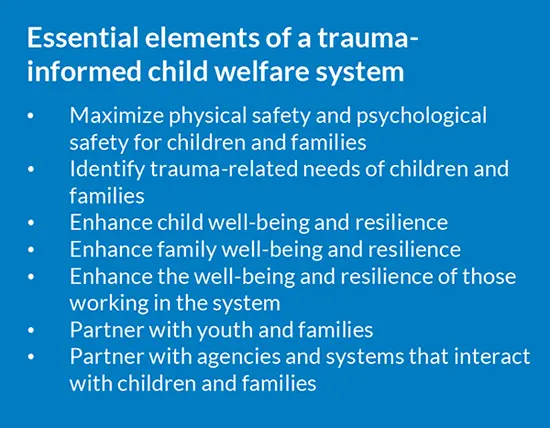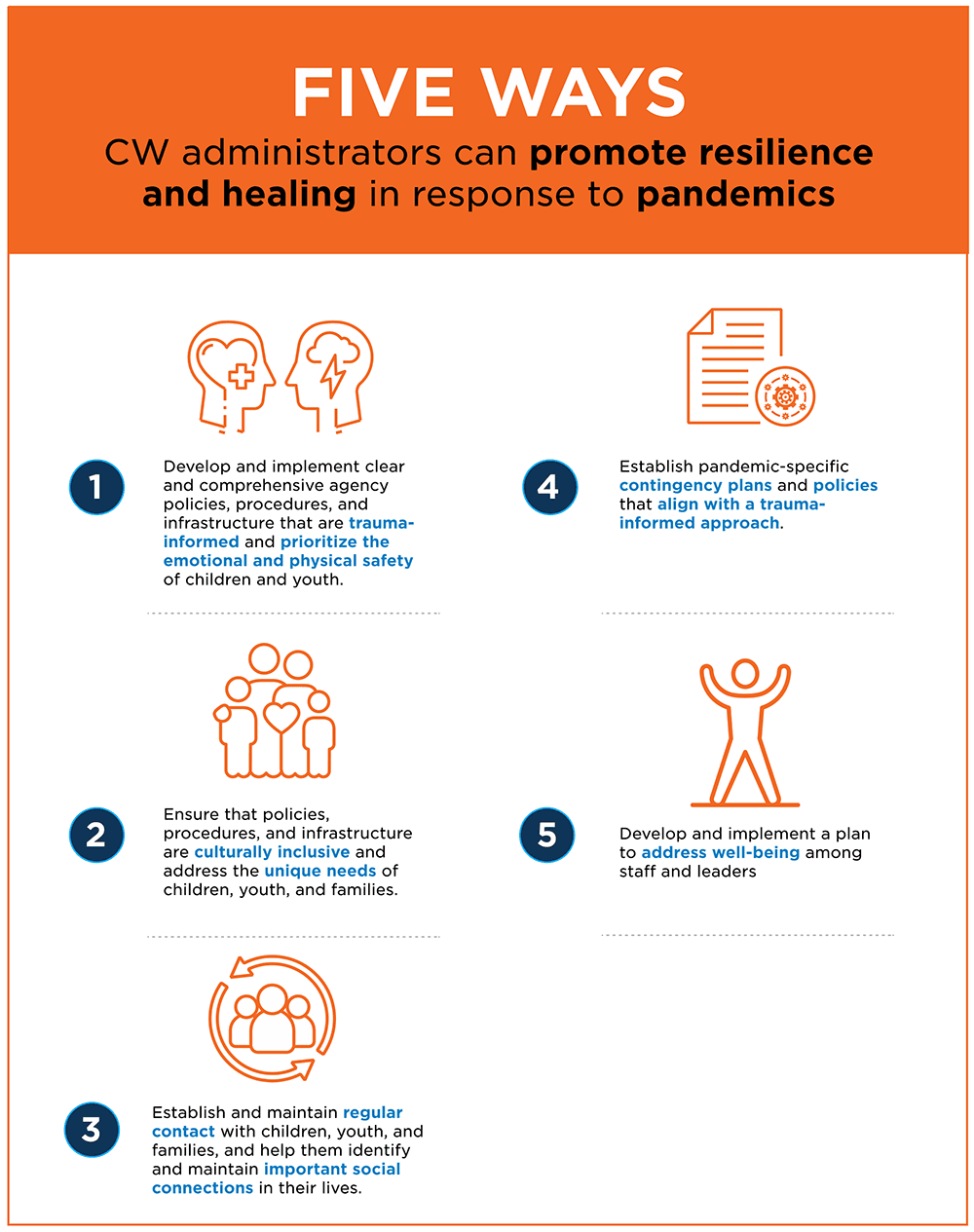Trauma-Informed Strategies for Supporting Children and Youth in the Child Welfare System during COVID-19
This brief provides guidance for child welfare (CW) administrators and staff to promote healing and increase the likelihood of resilience among children and youth, despite the many adversities associated with the COVID-19 pandemic and their involvement in the CW system.
Resilience and healing among children and youth involved in child welfare
Children and youth who become involved in the child welfare (CW) system often experience trauma as a result of maltreatment and other adversities while in the CW system, including removal from home and multiple out-of-home placements. Children and youth of color, particularly Black and Native American children, are disproportionally represented in the CW system and are more likely to experience trauma due, in large part, to structural racism and historical trauma. LGBTQIA+ youth (lesbian, gay, bisexual, pansexual, transgender, genderqueer, queer, intersexed, agender, asexual, and the ally community) are also at high risk for trauma while in the CW system.
The good news is that decades of research on resilience shows that protective factors can help children and youth thrive in the face of trauma and adversity. Although children and youth who are exposed to trauma are at greater risk for negative impacts on their brain development (e.g., responding to threat cues, managing emotions like anxiety and anger), as well as mental health and physical health problems over the life course, it is essential that CW professionals recognize the strengths and potential of all children and youth to succeed in life. Rather than focus on risk and deficits (e.g., “What’s wrong with you?”), CW agencies should focus on the experiences that led to trauma (e.g., “What happened to you?”); agency staff should also help children and youth build on their strengths and leverage these to recover, heal, and lead fulfilling lives (e.g., “What’s right with you?”).
Download
Key Terms
Trauma is one possible outcome of exposure to adversity. Trauma occurs when a person perceives an event or set of circumstances as extremely frightening, harmful, or threatening—either emotionally, physically, or both.
Adversity is a broad term that refers to a wide range of circumstances or events that pose a serious threat to physical or psychological well-being.
Resilience is the process of positive adaptation to adversity that arises through interactions between individuals and their environments.
Pandemic is an outbreak of a disease that occurs over a wide geographic area and affects an exceptionally high proportion of the population.
To promote positive child outcomes among children and youth in the CW system, it is essential to first understand that they are not “doomed” to poor life outcomes. Research affirms that certain types of supports are especially likely to help children and youth thrive after traumatic experiences such as pandemics. In fact, a number of evidence-based interventions and approaches can help mitigate the negative effects of trauma and positively impact brain development. Among the most important factors in promoting resilience to trauma and supporting healthy brain development among children and youth is having at least one reliable, nurturing caregiver.
In addition, it is critical to ensure that children and youth can access inclusive supports that are sensitive and responsive to their race, ethnicity, gender, gender orientation, and LGTBQIA+ identity. For staff to serve children and youth most effectively, it is essential that they become more aware of their own biases and attitudes; enhance their knowledge about children and youth experiences, beliefs, and values; and increase their comfort and skills in talking to children and youth about the role of race, ethnicity, gender, and sexual orientation. Establishing culturally responsive practices can mitigate the effects of disparity and disproportionality that persist in the CW system.
Finally, CW agencies must have appropriate knowledge of and sensitivity to the potential impact of trauma on the well-being of children and youth, as well as a trauma-informed approach to CW service provision.
Effects of COVID-19 on the child welfare system
COVID-19 presents new, unprecedented challenges for CW agencies to navigate while supporting children and youth under their care. Children, youth, and staff may experience these challenges within the CW system itself, at home, or in the community. Common pandemic-related challenges that children and youth experience in CW include:
- Disruptions to services and supports
- Increased financial hardship and stress among parents/caregivers
- Separation from family and friends
- Fear of, or actual, illness/death of someone due to COVID-19
In light of these challenges, it is equally important to promote children’s emotional safety and well-being during COVID-19 as it is to ensure their physical safety. The disproportionality in COVID-19 infections is also important in understanding which children and youth are most likely to be adversely affected, and which would most benefit from support as a result. For example, people of color—especially Black people—are experiencing higher rates of COVID-19 infection than White people. In addition, identifying and providing supports that promote child and youth emotional development and healing in culturally responsive ways is a critical component of pandemic preparedness and response for CW systems. Fortunately, research shows that a trauma-informed approach that promotes resilience to disasters and pandemics can be highly effective, especially when it is sensitive to the needs of individuals of different races, ethnicities, genders, gender orientations, and LGBTQIA+ identities.
A trauma-informed child welfare system to promote resilience and healing
Trauma training for CW leadership, staff, and resource parents is an important first step, but is insufficient for developing a trauma-informed CW system that supports positive child and youth development after traumatic events or circumstances. A trauma-informed CW system integrates trauma knowledge into all aspects of an agency’s daily operations and services through trauma-informed care: 1) it realizes the widespread impact of trauma and potential paths for recovery; 2) it recognizes the signs and symptoms of clients, families, staff, and others involved in the system; 3) it responds by fully integrating knowledge about trauma into agency policies, procedures, and practices; and 4) it resists re-traumatization by avoiding situations that trigger memories of painful events and circumstances. In line with this approach, the National Child Traumatic Stress Network (NCTSN) identified essential elements of a trauma-informed CW system

The infographic below offers five ways that CW administrators can mitigate pandemic-related trauma and support resilience in children and youth affected by COVID-19.

Five ways CW administrators can promote resilience and healing in response to pandemics
1. Develop and implement clear and comprehensive agency policies, procedures, and infrastructure that are trauma-informed and prioritize the emotional and physical safety of children and youth.
- Review and amend existing protocols and procedures and use ongoing risk and safety assessment to ensure comprehensive identification and response to child abuse and neglect when in-person visits are limited or not possible.
- Implement trauma-informed curricula across CW agencies and partnering community agencies to ensure a common language and coordinated response for addressing child and youth trauma (e.g., Psychological First Aid, Skills for Psychological Recovery, Trauma Systems Therapy-Foster Care, ARC Reflections, Child Welfare Trauma Training Toolkit, Resource Parent Curriculum).
- Include universal trauma screening for children and youth involved in CW to identify trauma and related psychological and behavioral issues. Use an effective screening tool—one that is valid, reliable, and age- and culturally sensitive; that assesses adversities both at home (e.g., child abuse and neglect, domestic violence, parental substance abuse or mental illness, domestic violence) and in the community (i.e., social determinants of health such as poverty, community violence, natural disasters and pandemics); and that assesses both exposure to adversity (types) and trauma symptoms (reactions). Consider using a tool adapted for pandemics (e.g., UCLA Brief COVID-19 Screen for Child/Adolescent PTSD).
- Develop formal partnerships with community service organizations, including a system for referral and follow-up and a plan to reduce structural and social barriers to accessing evidence-based and evidence-informed trauma and mental health interventions. These partnerships will enable CW staff to quickly and effectively address families’ emotional and basic needs.
- Consult the Title IV-E Prevention Services Clearinghouse to identify effective preventive interventions for children, youth, and families that meet federal criteria for reimbursement.
2. Ensure that policies, procedures, and infrastructure are culturally inclusive and address the unique needs of children, youth, and families.
- Provide training for staff and leaders on strategies for reducing and eliminating individual and institutional bias based on race, ethnicity, class, gender, and gender orientation.
- Use anti-racist CW practices to reduce inequities in trauma exposure.
- Partner with children, youth, and families to learn about their background, identity, and orientation (cultural, sexual, gender) and integrate a culturally inclusive, LGTBQIA+ responsive approach to CW services that supports and affirms their values, beliefs, and strengths.
- Establish a plan for supporting families in under-resourced communities during a pandemic.
3. Establish and maintain regular contact with children, youth, and families, and help them identify and maintain important social connections in their lives.
“If you want to continue to be better at your job, you got to understand that there’s just a lot of stuff going on. You don’t know how people feel. You don’t know how these children could’ve lost somebody close to them. So that’s the biggest thing. Make sure they have communication to their family, their friends. Make sure that you’re being patient. These children might be going through emotional things right now. I would say treat people like you would treat yourself. If you want love, show somebody else love.”
“The social workers should be calling you once or twice a month just to check up with you. Communication is really big during situations like this.”
- Maintain frequent and ongoing contact with children, youth, and families to monitor their physical and emotional risk, safety, and well-being while following safety guidelines.
- When in-person contact is not possible, the U.S. Department of Health and Human Services recommends that CW agencies use alternative communication and monitoring strategies, including virtual meetings, electronic communication, telephone contact, and socially distant meetings.
- Support and help maintain social connections between children and youth and their families, friends, and communities to provide social support and ongoing information about their safety. Identify creative methods and flexibility in agency operations to help children and youth connect with others, including through the use of technology (e.g., telephone, text messaging, virtual meetings).
- Tailor strategies to the child’s age and developmental stage. For young children, case planning and implementation requires close contact with their caregivers. Ensure that older children and adolescents have contact with peers, siblings, and caring adults.
4. Establish pandemic-specific contingency plans and policies that align with a trauma-informed approach.
- Ensure that disaster planning includes specific language about child and youth mental health and trauma and offers pandemic-specific guidance for child abuse and neglect screening, investigation, and case planning, as well as children’s placement needs and transitions, concrete needs, and visits with caseworkers and families. Careful attention should be paid to addressing the specific needs of youth transitioning out of care (e.g. maintain eligibility for foster care).
- Engage children, youth, and their caregivers (biological parents, resource parents, adoptive parents) in identifying their strengths and needs specific to the pandemic; provide clear messaging about the effects of pandemics with the best available scientific evidence to date.
- Closely monitor changes in federal, state, and county child welfare policy designed to address pandemic-related challenges and support child, youth, family, and staff well-being.
- Engage in cross-system collaboration with other national, state, and local child- and family-serving organizations and emergency systems (e.g., Red Cross, FEMA, law enforcement, schools) to coordinate a trauma-informed response.
5. Develop and implement a plan to address well-being among staff and leaders.
“Because of the crisis, there have been much more open lines of communication about what is hard—because it’s hard for everyone, and it’s expected to be hard. Building those relationships has been really important in the system and, hopefully, will carry forward to a more partner-based relationship.”
“In order to help [youth], professionals need to understand what trauma is and how it impacts—not only the kids, but [themselves], because there are so many professionals in the system who have not addressed their own trauma, whether it be adverse childhood experiences, COVID-19, racial discrimination, or other [experiences].”
- Formalize strategies for preventing, identifying, and addressing secondary traumatic stress and vicarious trauma among CW staff and leaders by creating a workforce wellness plan that promotes high-quality, trauma-informed services and reduces staff burnout and turnover (the average turnover rate was estimated to be 20-40% prior to the pandemic).
- Increase staff awareness of the potential impacts of working with traumatized individuals on their own well-being, and emphasize the importance of prioritizing self-care (e.g., mindfulness, exercise, good nutrition, rest, social support, therapy) during the pandemic.
- Screen for secondary traumatic stress among staff (e.g., Professional Quality of Life Measure, Secondary Traumatic Stress Scale) and in the organization (e.g., Secondary Traumatic Stress Informed Organization Assessment), and offer information for obtaining support.
- Provide ongoing, high-quality, reflective, and trauma-informed supervision.
Additional Resources for Supporting Children & Youth in the CW System During COVID-19
- Complex Trauma: In Urban African-American Children, Youth, and Families (Substance Abuse and Mental Health Services Administration, National Child Traumatic Stress Network)
- Creating Trauma-Informed Child Welfare Systems: A Guide for Administrators (Chadwick Trauma-Informed Systems Project)
Creating Trauma-Sensitive Communities (The Annie E. Casey Foundation) - Culturally Responsive Child Welfare Practice (Center for Advanced Studies in CW, University of Minnesota School of Social Work)
- LGBT Resources for Child Welfare Professionals (Human Rights Campaign Foundation)
- Screening, Assessing, Monitoring Outcomes and Using Evidence-Based Interventions to Improve the Well-Being of Children in Child Welfare (U.S. Department of Health and Human Services, Administration for Children and Families, Children’s Bureau)
- Secondary Traumatic Stress in Child Welfare Practice: Trauma-Informed Guidelines for Organizations (Chadwick Trauma-Informed Systems Dissemination and Implementation Project)
- Trauma-informed Care Fact Sheet: Native Children: Trauma and its Effects (National Indian CW Association)
- What COVID-19 Means for America’s Child Welfare System (Brookings)
- Resources for Supporting Children’s Emotional Wellbeing During the COVID-19 Pandemic (Child Trends)
- Ways to Promote Children’s Resilience to the COVID-19 Pandemic (Child Trends)
- COVID-19 Resources (Children’s Bureau, Administration for Children and Families)
- Coronavirus (COVID-19) Information, News, & Resources for Child Welfare Professionals and Others (Child Welfare League of America)
Acknowledgements and disclaimer
This research was funded by the Annie E. Casey Foundation. We thank them for their support, particularly Mildred Johnson, and acknowledge that the findings and conclusions presented in this brief are those of the authors alone, and do not necessarily reflect the opinions of the Foundation. We also thank the youth and child welfare administrators who participated in focus groups and key informant interviews to inform this brief.
© Copyright 2024 ChildTrendsPrivacy Statement
Newsletter SignupLinkedInThreadsYouTube
